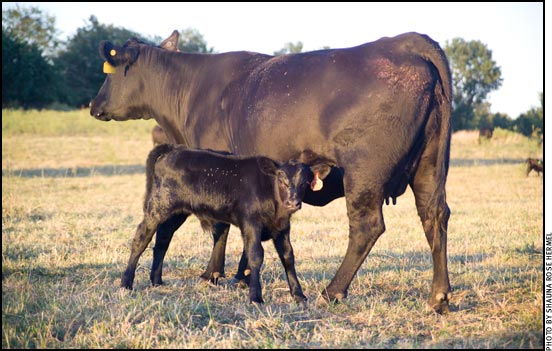HEALTH & NUTRITION...

Gestation Intervals Shorter in Heat
Excessive summer heat may cause fall calves to be born
earlier than normal.
Cattle producers with fall-calving herds need to be aware that calves may be born earlier than normal this year because of the extremely hot summer experienced by the Southern Great Plains states.
"It's a good idea for producers to begin their routine heifer and cow checks at least a week to 10 days prior to the normally expected first-calving date," said Glenn Selk, Oklahoma State University (OSU) Cooperative Extension emeritus cattle specialist. Read more.

Consider Turnout Date Before Applying Pyrethroids
Preliminary evidence suggests bulls may need time to recover to maximize fertility.
Speaking during the Applied Reproductive Strategies in Beef Cattle (ARSBC) conference in Joplin, Mo., Aug. 31-Sept. 1, University of Missouri (MU) veterinarian Dietrich Volkmann discussed commonsense practices for managing breeding bulls. To a fairly familiar list of recommendations he added a warning related to external parasite treatments involving a common class of insecticides. Volkmann cited evidence suggesting pyrethroid products may temporarily affect bull fertility.
Research indicates pyrethroids may inhibit production of an enzyme responsible for the conversion of testosterone to dihydrotestosterone, a hormone necessary to the proper function of multiple accessory sex glands. As a result, said Volkmann, bulls may produce lower volumes of semen, sperm cells may be abnormal and the 'freezeability' of sperm collected from artificial insemination (AI) sires may be compromised. It is a temporary effect; semen quality will improve in four to six weeks. Volkmann said he would not expect a similar effect in cows since the underlying problem was in the conversion of testosterone to dihydrotestosterone. Read more.

Energy & Protein
Speaker at Applied Reproductive Strategies in Beef Cattle seminar addresses how energy and protein affect reproductive success and failure.
Reproductive failure among cows and heifers, either because females aren't cycling or because of embryonic mortality, is often related to their nutritional status. Addressing the Applied Reproductive Strategies in Beef Cattle (ARSBC) conference, in Joplin, University of Idaho Extension Beef Specialist and researcher John Hall said the relationship between nutrition and reproduction is likely an adaptive mechanism, which prevents reproduction during times of limited nutrient availability. During such times, maintenance of the cow's or heifer's own body takes precedence.
Hall reviewed the roles of energy and protein nutrition as related to reproduction. He called energy the nutrient of first concern, noting its role in regulating release of hormones. In addition to overall energy availability, the timing of energy increase or deprivation is important in determining pregnancy rates. Read more.
Foot Fetish
Identify and treat foot rot early to maintain herd health and durability.
Delayed corn planting and flooded pastures weren't the only problems cattlemen faced from heavy spring rains throughout much of the Midwest. The moist environments also increased the chance of cattle getting foot rot, says University of Missouri (MU) Clinical Assistant Professor and Extension Veterinarian Scott Poock.
Foot rot is often caused by puncture wounds or continuous exposure to wet conditions that allow a bacterial infection to enter through the skin between the toes in cattle and other hooved animals. Fusobacterium necrophorum is the bacterium most commonly associated with foot rot. It enters through the skin and multiplies, thus taking the infection deeper into the foot and leg. Grazing cattle and feedlot cattle can acquire foot rot that requires treatment, however producers should keep a particular eye on grazing cattle for symptoms. Read more.

Rick Rasby
Ridin’ Herd
Forage costs and planning ahead
It seems annual cow costs get higher each year, or at least they can potentially increase each year. This year is no exception. Drought has increased forage prices nationally. There are some management practices that are essential to consider this year.
There is no need to keep nonproductive cows around for any reason or any length of time. Pregnancy-check cows as soon as possible, and consider marketing options for those that are open. Read more.
What's a Dose Got to Do With It?
Ensure product efficacy by dosing and storing dewormers correctly.
Operating costs continue to rise, making it more critical than ever for producers to ensure they are getting optimal results from their cattle dewormer. To get the best result, it pays to dose and store the product correctly, since both factors can affect product efficacy.
To determine proper dosage, it is essential to have an accurate weight of each animal — underestimating weight can lead to underdosing of dewormers.1 Read more.
Researchers Uncover Genetic Link to Cattle Diseases
The origin of three costly cattle diseases is genetically linked, according to findings from U.S. Department of Agriculture (USDA) researchers.Scientists at the Agricultural Research Service (ARS) Roman L. Hruska U.S. Meat Animal Research Center (USMARC) in Clay Center, Neb., have discovered a location on bovine chromosome 20 that is associated with the incidence of the most prevalent bacterial diseases — pinkeye, foot rot and bovine respiratory disease (pneumonia) — that affect feedlot cattle.
Bovine respiratory disease (BRD) accounts for 75% of feedlot illnesses and up to 70% of all deaths, with economic losses to cattle producers exceeding $1 billion annually. The estimated costs for pinkeye are $150 million yearly, and losses to dairy producers due to foot rot range from $120 to $350 per animal. Read more.
Cattle Diseases: Common Conditions/Terms
Click here for a list of common conditions and terms related to beef cattle diseases, such as anaplasmosis, brucellosis, BVD, E. coli, IBR and others.
[Click here to go to the top of the page.]













